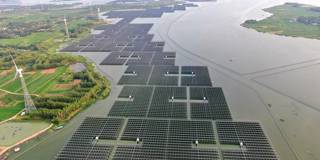As China puts the worst of the COVID-19 crisis behind it, reopens factories, and resumes trade with its neighbors, the country's leaders must strike the right balance between maintaining short-term growth and laying the foundations of future growth. Accelerating progress toward a low-carbon economy would be a good way to do that.
LONDON – When the 2008 global financial crisis erupted, China’s exports collapsed, threatening massive job losses. In response, China unleashed the world’s biggest-ever construction boom, pouring more concrete between 2011-13 than the United States did in the entire twentieth century.
Total investment rose from 43% to 48% of GDP during this period, and total debt from 140% in 2008 to over 200% by 2013, reaching 250% by 2017 as banks lent freely to local governments, state-owned heavy industry, and real estate developers. Construction jobs increased from 39 million to 53 million, and total urban employment continued growing at the annual pace of 12 million needed to absorb migration from rural areas. Annual GDP growth dipped only slightly, from 9.6% in 2008 to 9.2% in 2009.
Today, China faces a similar challenge. Like other Asian economies, it has contained the COVID-19 threat more effectively than Western Europe or the US; almost all its factories are open again, and April’s export figures show buoyant trade with Asian neighbors. But with Western developed economies still in partial lockdown and likely to recover only slowly, China faces huge headwinds to growth. The temptation will be to repeat a construction-led stimulus.

LONDON – When the 2008 global financial crisis erupted, China’s exports collapsed, threatening massive job losses. In response, China unleashed the world’s biggest-ever construction boom, pouring more concrete between 2011-13 than the United States did in the entire twentieth century.
Total investment rose from 43% to 48% of GDP during this period, and total debt from 140% in 2008 to over 200% by 2013, reaching 250% by 2017 as banks lent freely to local governments, state-owned heavy industry, and real estate developers. Construction jobs increased from 39 million to 53 million, and total urban employment continued growing at the annual pace of 12 million needed to absorb migration from rural areas. Annual GDP growth dipped only slightly, from 9.6% in 2008 to 9.2% in 2009.
Today, China faces a similar challenge. Like other Asian economies, it has contained the COVID-19 threat more effectively than Western Europe or the US; almost all its factories are open again, and April’s export figures show buoyant trade with Asian neighbors. But with Western developed economies still in partial lockdown and likely to recover only slowly, China faces huge headwinds to growth. The temptation will be to repeat a construction-led stimulus.